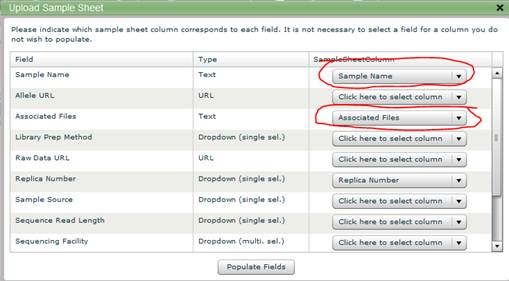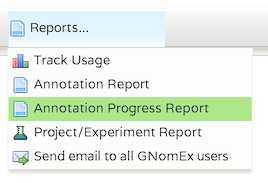- Welcome
- Introduction
- Publications and presentations
- Signing in
- System requirements
-
How To
- Logging into GNomEx
- Submitting an experiment request
- Submitting a microarray hybridization request
- Submitting a sample quality request
- Submitting a sequencing request
- Requesting that microarray hybridization or sequencing be performed on samples previously submitted to sample quality testing
- Adding lanes to a previously submitted sequencing request
- Registering an external experiment in GNomEx
- Finding and viewing a summary of an experiment
- Editing an experiment
- Downloading experiment results
- Linking the samples from an experiment to their BST sample
- Viewing analyses
- Downloading analyzed data files
- Viewing a description of the materials and the methods used during processing of a specific kind of experiment
- Performing a search for experiments and analyses meeting a specific type of criteria
- Submitting a work authorization
- How pricing and billing works in GNomEx
- Adding a new price criterion
- Creating a new price sheet
- Creating a new price category
- Modifying an existing price sheet
- Modifying an existing price category
- Modifying an existing charge item
- Preparing and sending out invoices for clients
- Generating general ledger interface data for automatically billing university accounts
- Window, Tab, and Field Descriptions
-
GNomEx Error Messages and Information Windows
- Are you sure you want to delete all the hybridizations?
- Are you sure you want to delete all of the samples?
- At least one non-empty file must be selected in order for download to proceed.
- Please enter all of the required fields for the hybridization.
- Please enter all required fields for the samples.
- Please enter at least one search criterion.
- Please select a price category.
- Please select a price sheet.
- Remove all hybs currently showing in the list?
- Remove all samples currently showing in the list?
- The number of samples to setup has changed. Do you want to clear out the existing samples?
- The request has not been saved. Are you sure you want to quit?
- The request is now assigned to project.
- The webpage you are viewing is trying to close the window.
- Unable to generate GL interface. Cannot find approved folder.
- You are no longer logged on. Please logon again.
- Your changes have not been saved. Are you sure you want to exit?
-
Working With the List of Samples Submitting for Microarray Hybridization
- Adding a Sample to the List of Samples You Will Be Submitting for Microarray Hybridization
- Adding a sample to the list of samples you will be submitting for microarray hybridization that is similar to another sample already in the list
- Deleting a sample from the list of samples you will be submitting for microarray hybridization
- Deleting all of the samples currently included in the list of samples you will be submitting for microarray hybridization
-
Working With the List of Hybridizations By Requests
- Adding a hybridization to the list of hybridizations you will be requesting
- Adding a hybridization to the list of hybridizations you will be requesting that is similar to another hybridization already in the list
- Deleting a hybridization from the list of hybridizations you will be requesting
- Deleting all of the hybridizations currently included in the list of hybridizations you will be requesting
- Editing a hybridization from the list of hybridizations you will be requesting
- Working with the list of hybridizations you will be requesting
- The hybs tab (submit microarray hybridization request window)
- The submit microarray hybridization request window
- Submitting a microarray hybridization request
- Microarray hybridization requests
-
Specialized Role Topics
- Uploading a sample sheet
- Setting/changing the prices of a charge item
- Setting/changing the experiment type(s) associated with a price sheet
- Setting/changing the criteria by which a charge item will be applied to billing for an experiment
- The sample view tab (new experiment module)
- The hyb setup tab (new experiment request module)
- The hyb view tab (new experiment request module)
- The new project window
- The edit project window
- Adding a new project while you are entering a microarray hybridization request
- Editing an existing project while entering a microarray hybridization request
- Adding a new sample characteristic for annotation while submitting a sample hybridization
- Editing an existing sample characteristic for annotation while submitting a sample hybridization
-
Guides
- User Guide
- Experiment orders
- The foundation of GNomEx
- Experiments at a glance
- Submitting a HiSeq or MiSeq experiment order
- ABI Capillary (Sanger) Sequencing
- Checking on experiment progress
- Copy and pasting into samples grid
- Posting outside experiment data
- iScan experiments
- Downloading and uploading your data
- The download files window
- Downloading large data sets
- Downloading chromatograms
- Fast data transfer from the command line
- Troubleshooting guide for downloading
- Launching FDT with Webstart
- Uploading your data
- Annotating your experiment
- Associating experiment files back to the samples
- Sample annotations
- Copy and paste for the samples grid
- Bulk sample sheet import
- Analysis and data tracks
- Create an analysis
- Data tracks
- Disk usage
- Configuring GNomEx
- Context-sensitive help
- Customize the billing account fields
- Dictionaries
- Seq lib protocols and barcode schemes
- Configuring HiSeq rapid mode sequencing options
- Developer Guide
- Installation Guide
- Configuring GNomEx for FDT
- Configuring GNomEx to use LDAP Authentication
- Compiling and Building
- The Database Schema
- GNomEx Open Source
- Developer Documents
- Illumina HiSeq Realtime Info — The Metrix Server
- FAQs
- Demo
Sample annotations can be entered or updated at any time. Most frequently, annotations will be uploaded at the time an experiment is created. However, GNomEx also allows for additional annotations to be added to existing experiments, and for existing annotations to be edited or updated.
Entering sample annotations for a small number of samples
1. Create Project and Experiment , or select an existing Experiment
2. In the Experiment window, click on the Edit link. NOTE: The Edit link will only be visible for Experiments for which you have editing privileges. The Owner, Lab PI, and Admin group all have editing privileges."][/tagline_box]
3. Click on the Annotations tab, and check the boxes for all applicable annotations. All 'required' annotations will already be checked.
4. Click on the Samples tab. You will see empty fields highlighted in yellow. Click a cell and enter the appropriate information for that sample annotation. Enter information for all samples and all fields for which you have annotation data. You do not need to enter information into every cell.
5. Additional samples can be entered by right-clicking and selected the 'Add Sample' menu. There is also a menu option to 'Duplicate Sample'.
6. Click Next
7. Review entered data. If everything is correct, press the Save button.
Updating existing annotations using the Download Sample Sheet.
This upload function works on an experiment level. If you want to update sample annotations across multiple experiments, you can use the Bulk Sample Sheet Import.
The steps below show how to update a single annotation for a group of samples. For example, if a gene is discovered after sequencing files are uploaded, then the annotation called Allele Name will need to be updated to correspond with the Gene Name, and the Gene Name will need to be added.
1. Select an existing Experiment, click Edit, and go to the Samples tab.
2. Click on the 'Download Sample Sheet' link. Save the .txt file.
3. Open the .txt Sample Sheet file in Excel. Make your changes to the spreadsheet and save. There will be many columns that don't apply. Save your .txt file in Excel. (You must keep it in this format for the upload to work).
4. Now click on the 'Upload Sample Sheet' link. Select the file you just modified.
5. Only pick the annotations you intend on updating. For the most part, the wizard should do this for you by only selecting the columns that have data filled in.

Figuring out which Required Annotations are Missing
To get a report showing how completely the annotations are filled in for each lab's experiments, run Reports -> Annotation Progress Report.

This will generate an Excel spreadsheet that provides three worksheets. The first sheet shows the experiments missing 'required' sample annotations. The cells marked in red denote missing annotations.

The last column indicates if experiment files are associated back to the appropriate samples. If this column is marked red, you will need to associate the experiment files back to the samples using this from the 'Manage Files' window. This feature is described here: Associating Experiment Files back to the Samples.




